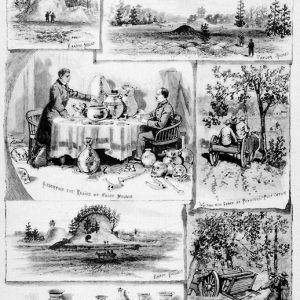calsfoundation@cals.org
Edward Palmer (1830?–1911)
Edward Palmer conducted most of the fieldwork for the first major study of Indian mounds in Arkansas. His research helped dispel myths about who built the mounds.
Edward Palmer was born in England, near Hockwold-cum-Wilton in southwestern County Norfolk, into a family of gardeners. The year of his birth is uncertain, but it was probably 1830; the date was definitely January 12. His father’s name is listed variously as William or Robert, and his mother’s maiden name was Mary Ann Armiger; Palmer’s own middle name is unknown.
Little is known about Palmer’s early life. He came to America in 1849 and moved to Cleveland, Ohio, where he was strongly influenced by the eminent naturalist Jared Kirtland. He worked as a “natural history” specimen collector on an 1852–55 U.S. Navy expedition to South America. Palmer married Dinah Riches while visiting England in 1855. She came to America with him, but nothing is known about what happened to her. He attended the Cleveland Homeopathic College from 1856 to 1857. He took the title of “Doctor” and practiced medicine at times, but he preferred collecting specimens.
Palmer joined the U.S. Army in 1862 and served as an assistant surgeon until 1868. After the Civil War, he became one of the nineteenth century’s leading field collectors of botanical specimens, especially in the American Southwest and Mexico. He also collected other materials for study in biology, geology, ethnology, and archaeology, working for sponsors including Harvard University and the Smithsonian Institution.
Between 1882 and 1884, he was one of several field assistants for the Smithsonian Institution’s Bureau of Ethnology, Mound Exploration Division, which conducted an extensive survey of Indian mounds in the eastern U.S. Arkansas was the state most intensively studied, and Palmer conducted most of that research. He also investigated mounds in Alabama, Louisiana, Mississippi, Tennessee, and other states.
While in Arkansas, Palmer worked mainly in the eastern Delta lands where mounds were most abundant. Among many now-famous sites where he was the first, or one of the earliest, scientific investigators are Plum Bayou Mounds Archeological State Park, the Menard-Hodges Site (Arkansas County), the Tillar and Taylor Mounds (both in Drew County), the Hughes Mound near Benton (Saline County), and the Chickasawba Mound at Blytheville (Mississippi County). He spent three major field seasons in Arkansas—October 1881 to January 1882, October 1882 to February 1883, and September to November 1883—plus one short period in late June and early July 1884.
The project’s final report, written by the division’s director, Cyrus Thomas, was published in 1894 and dispelled racist theories that the mounds had been constructed by a non-Indian “lost race of Mound-Builders” by presenting evidence that they had been built by the ancestors of historical eastern U.S. tribes.
Palmer’s publications indicate that he was prejudiced against Indians (or at least, Indian men). However, he was sympathetic toward the recently freed slaves. In late 1882, he hired Henry Jackson Lewis—who had been born into slavery in Mississippi but was then residing in Pine Bluff (Jefferson County)—to make drawings of the mounds for him. Lewis also drew mounds in Louisiana, Mississippi, and Tennessee for Palmer.
After the mounds project was completed, Palmer returned to botanical and “natural history” collecting from his base in Washington DC and was active almost to his death on April 10, 1911. He is buried in Rock Creek Cemetery in Washington DC.
For additional information:
Jeter, Marvin D. “The Palmer-Lewis ‘Mound Survey’ Forays into Tennessee, Mississippi, and Louisiana, 1881–1883.” Mississippi Archaeology 25 (December 1990): 1–37.
Jeter, Marvin D., ed. Edward Palmer’s Arkansaw Mounds. Fayetteville: University of Arkansas Press, 1990.
McVaugh, Rogers. Edward Palmer: Plant Explorer of the American West. Norman: University of Oklahoma Press, 1956.
Marvin D. Jeter
Arkansas Archeological Survey





Comments
No comments on this entry yet.